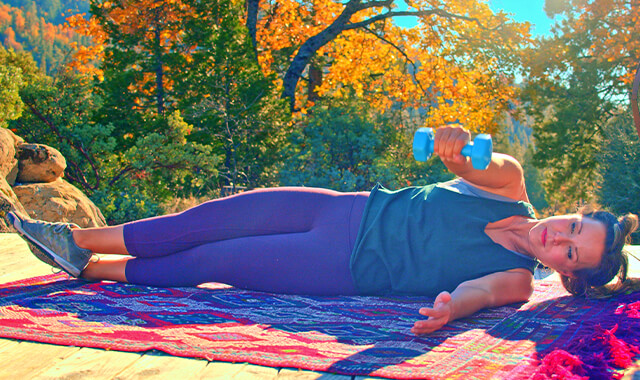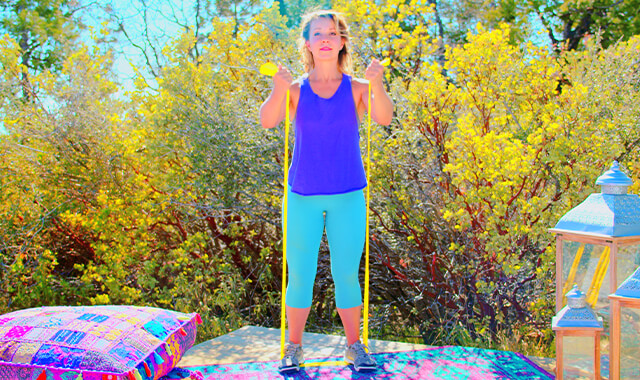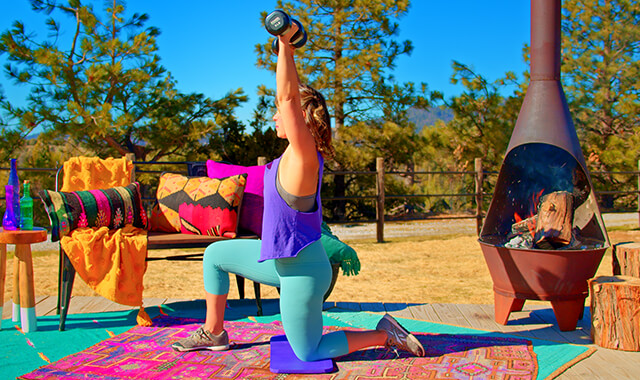4-Way Band Delt Raise
How to Do the 4-Way Band Shoulder Press Deltoid Raise | In-Depth Guide [VISUAL LEARNERS] Intermediate
Proper Form, Common Mistakes, Variations + Easier & Harder | Home Resistance Training
WHAT DO YOU WANT TO SEE?
QUICK DEMO
QUICK DEMO
MUSCLES THIS WORKS
MUSCLES
MAIN MUSCLES WORKED IN 4-Way Band Deltoid Raises
Front & side deltoid
OTHER MUSCLES WORKED:
- Rotator cuff
WHAT WE'RE DOING TODAY
WHAT & WHY
BENEFITS OF TRAINING THE Front and Side Deltoid
WHAT
WHAT WE'RE DOING TODAY
ALL WE'RE DOING:
You have to watch the video! It's too hard to explain.
The goal of the band version of the 4-way deltoid raise is to strengthen the front and side portions of our main shoulder muscle called the deltoid or delt.
The arms are moved through 4 directions in a continuous motion - out to the side of the body to shoulder level, to the front of the body, back out to the sides, and down to the sides at the hips. After completing half of the reps, the arms are moved to the front of the body to complete the sequence by lifting the arms up to the front, moving them out to the side, back to the front, and down again.
The side (lateral) part of the deltoid are targeted when the arms are lifted out to the side (abduction) and lowered back down (adduction), and the front (anterior) part of the deltoid is working when the arms are lifted to the front (flexion) and lowered back down (extension). This would be similar to combining a forward delt raise and a lateral delt raise.
WHY BOTHER DOING IT?
WHY
WHY DO WE EVEN CARE?
STRENGTHEN THE MUSCLES THAT ARE INVOLVED IN MOST ARM MOVEMENT
The deltoid muscle is the prominent muscle that sits on the top of the shoulder joint. It is the main muscle for moving the arm to the front, side, and back of the body. The deltoid muscle has three different parts, the front (anterior), side (lateral), and rear (posterior). Each part of the muscle moves the upper arm in a different direction. The different parts of the muscle are named for where the muscle lies on the shoulder, which is the same as the direction they move the arm.
The banded 4-way deltoid raise will work both the front and side parts of the deltoid muscle. Most of our daily activities involve moving our arms to the front and/or out to the side - having strong deltoids improve your ability to lift, hold and carry. This exercise will also strengthen the rotator cuff muscles and the muscles that move and stabilize the shoulder blade which contributes to good posture.
BAND HAS SMALL ADVANTAGE OVER DUMBBELLS HERE
There is an added bonus when you use a band for this exercise, as you move the arms between the side and the front of the body, there will be a portion of the movement where both the side and front parts of the deltoid will be working. For example, The side deltoid will lift the arm up from the side of the body and hold it up as the arm moves horizontally (parallel to the floor) to the front, about ½ way to the front, the front deltoid will become more active and as it continues to the front the side deltoid will become less active. It is always a good idea to vary your exercises to work the muscles in a variety of different ways. The banded 4-way deltoid raise does a really nice job of working the parts of the deltoid independently and also together. This is much more like real-life activities - we are usually moving our arms in a variety of different directions as opposed to straight up or straight down.
EVERYDAY LIFE
EVERYDAY LIFE &
MUSCLE FUNCTION
HOW WE USE OUR FRONT AND SIDE DELTOID MUSCLES IN EVERYDAY LIFE
1. FRONT (ANTERIOR) DELTOID
Lift the arm to the front (flexion).
- Putting dishes into the cupboard
- Hanging clothes in the closet
- Washing windows
- Lifting a child out of a crib
- Painting a wall with a roller
- Lifting a pan from the oven
- Lifting a gallon of milk out of the refrigerator
Holding the arm in front of you.
- Pushing a wheelbarrow
- Using a can opener
- Carrying a laundry basket
Turning the upper arm inward (especially while lifting or holding the arm to the front, elbow straight) (this function is not targeted in this exercise).
- Using a screwdriver
- Closing a spigot
- Using a wrench
2. SIDE (LATERAL) DELTOID
Lifting arm out to the side (abduction).
- Dressing - putting on a shirt or coat
- Pulling up pants
- Reaching out to close the car door
- Carrying a child on one hip
Stabilizing the shoulder joint - pulls upward on the humerus against downward pulls. (not targeted in this exercise.
- Carrying heavy objects like suitcases, buckets, groceries
STARTING POINTERS
Starting Pointers
This is a combination movement that targets the anterior and lateral portions of the deltoid muscle. The exercise involves 4 separate movements completed in sequence.
The rotator cuff muscles, and the muscles that work to stabilize the shoulder, elbow and wrist joint will be active to help control the movement.
HOW TO FEEL WHAT MUSCLE IS WORKING
How to Feel What Muscle is Working
Place the opposite hand on top of your shoulder - lift the arm straight out to the side - you should feel the side or lateral deltoid contract.
Shift the fingers forward about half of an inch and lift the arm to the front. You should feel the front or anterior deltoid contract.
HOW TO DO THE EXERCISE
LOOKS
HOW 4-Way Band DelT Raises SHAPE OUR BODY
Toned, capped shoulders.
PROPER FORM
PROPER FORM: 4-Way Band Delt Raises
EQUIPMENT, SETS & REPS
EQUIPMENT
Main set (3: Light/Med/Heavy)
X-Heavy Band (I recommend getting this too if you plan to use resistance bands frequently).
SUGGESTED STARTING WEIGHT FOR WOMEN:
Light to moderate resistance bands
SETS & REPS:
1 set of 8-10 reps
PACE:
Controlled, continuous movement.
BODY POSITION
BODY POSITION FOR THE 4-Way Band Delt Raise
BAND: Secured under both feet.
FEET: Feet shoulder-width apart, toes pointed forward.
BODY STANCE: Neutral spine position, knees slightly bent, sternum lifted, shoulder blades in and down the back (this is only the starting position - the shoulder blades will move with the arm movement), space between the top of the shoulders and the ear lobe. Chest wide - this is important to avoid rounding the shoulders in.
ARM: Arms straight down by the sides.
GRIP: Hold one end of the band in each hand. Neutral grip - palms facing inwards - bring the band up to the thumb side, across the palm. It may be more comfortable to have the band wrap around the top of the hand. The band should be taut in the beginning position, but you must be able to move the hands up to shoulder level.
NECK: Neutral and relaxed.
HOW TO DO
HOW TO DO 4-Way Band Delt Raises
CUE: Fluid, controlled movement. Try to keep tension on the band - this may mean that your arms will not come all the way back down to your sides or to the front.
Keeping your elbows straight, lift arms out to the side (abduction) until they are at shoulder level. Palms will be down.
Move arms in until they are in line with the shoulders. Straight out in front of you. Palms will be facing down.
Move them back out to the sides and lower the arms down - so they are next to your thighs.
Repeat for the desired number of reps.
To complete the set:
Move the arms in front of the thighs. Lift the arms up to the front. Move the arms out to the side.
Bring the arms back to the front and lower down to the thighs.
Continue to complete an equal number of reps.
HOW TO SAFELY GET OUT OF THE EXERCISE
From the beginning position, let go of the band.

COMMON MISTAKES
COMMON MISTAKES
WHAT TO AVOID WITH THE 4-Way Band Delt Raise
KEY TIP:
Guess what? Good news! Many avoids are the same for most movements. Once you learn the basics, there's really only a few extra avoids for each individual movement.
1. Avoid Working Into Pain
AVOID: Avoid moving into pain.
WHY NOT?
- Pain is there for a reason. It doesn't mean that you can't gradually improve ability or mobility, but usually if you just push yourself through pain, it means that you are causing damage.
WHAT TO DO:
- As with all exercise movements, it's not all or nothing. Do the movement with whatever range of motion your body allows without pain. If you feel pain moving your shoulders overhead, skip that part and do the rest. Or lift just to the point before discomfort.

2. Avoid Moving Your Torso
AVOID: Avoid moving torso.
WHY NOT?
- Letting the torso get all loosey-goosey during arm movements puts strain on the spine in a way that is not healthy for it.
WHAT TO DO:
- Use a weight and slow control that allows you to keep your torso very still. It's your arms that are moving, from the shoulder joint, not the torso.
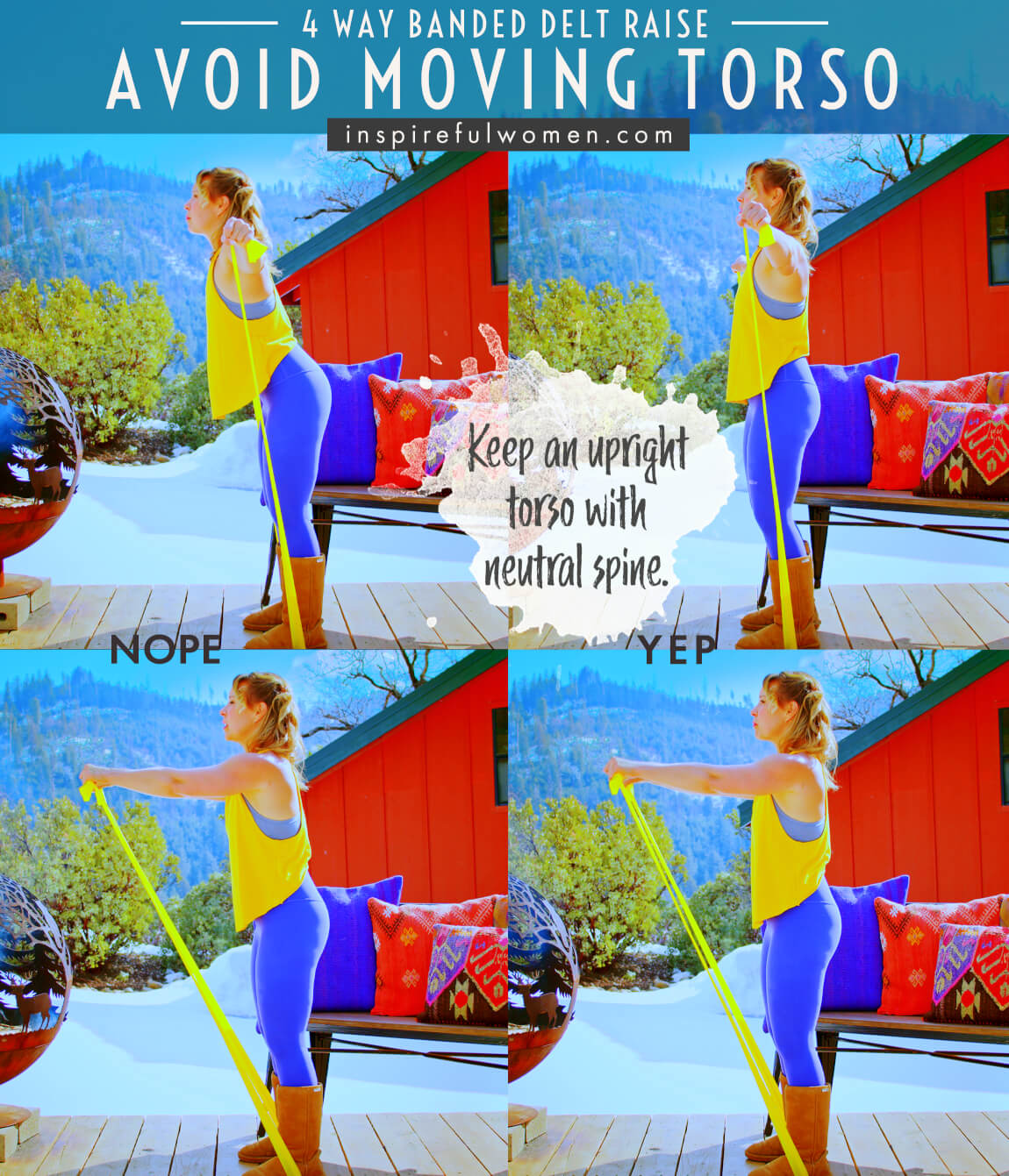
3. Avoid locking your knees
AVOID: Avoid straightening or locking your knees.
WHY NOT?
- If your knees are locked you may feel pressure or discomfort in the low back or knees.
- Locking your knees puts stress on the knee joint and can make it more difficult to maintain a neutral spine.
WHAT TO DO:
- Keep your knees soft with a slight bend.

4. Avoid Bending The Wrists
AVOID: Avoid bending your wrists.
WHY NOT?
- Poor alignment (bent forward or backward) or repetitive movement through the wrist can lead to joint and/or soft tissue irritation or injury over time.
WHAT TO DO:
- Your wrists should be in line with your forearm and should be still throughout the exercise.

5. Avoid Bending Your Elbow
AVOID: Avoid bending your elbow.
WHY NOT?
- This will make it easier because the weight is closer to your shoulder joint (shorter lever arm).
WHAT TO DO:
- Keep your elbows straight to challenge the muscles better.

VARIATIONS
VARIATIONS
VARIATIONS OF 4-Way Band Delt Raises
Single Arm
One Arm 4 way banded deltoid raise
Hold the non-working at shoulder level - either to the front or the side. This will increase the total time that the muscles are under tension and will work the muscles of the torso a little differently - the obliques and quadratus lumborum will be more active to prevent rotation and side bending (respectively) of the torso under the loading of one side.
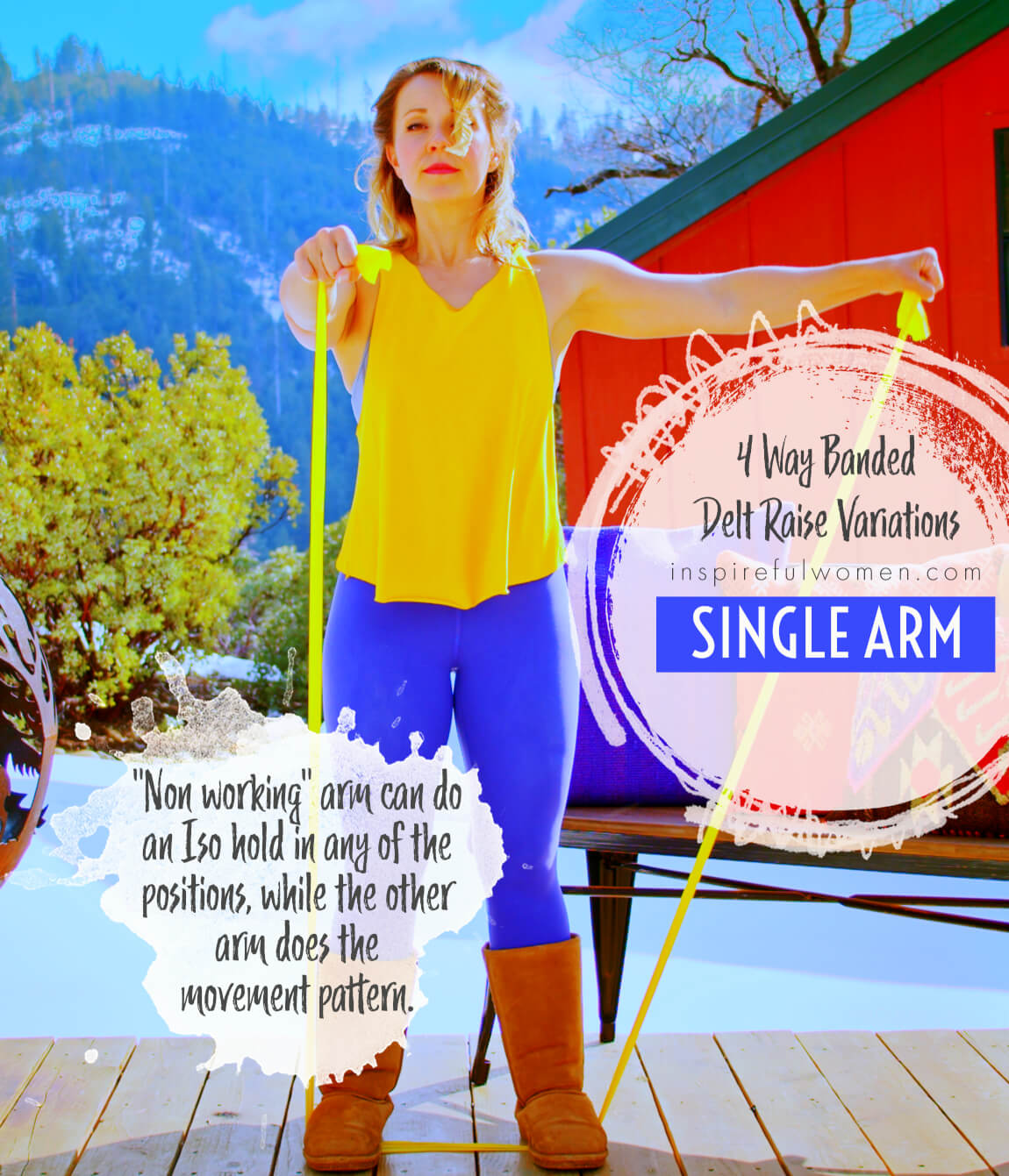
Speed Up Movement
Speed the movement Up
Speed the movement up but maintain control and fluidity, avoid rocking your body or swinging your arms. Complete the pattern ½ way in 2 seconds - up from sides to the front, overhead = 2 seconds.
Challenges the shoulder joint and core stabilizers. Trains the muscle to contract more quickly - to increase the power of the muscle.
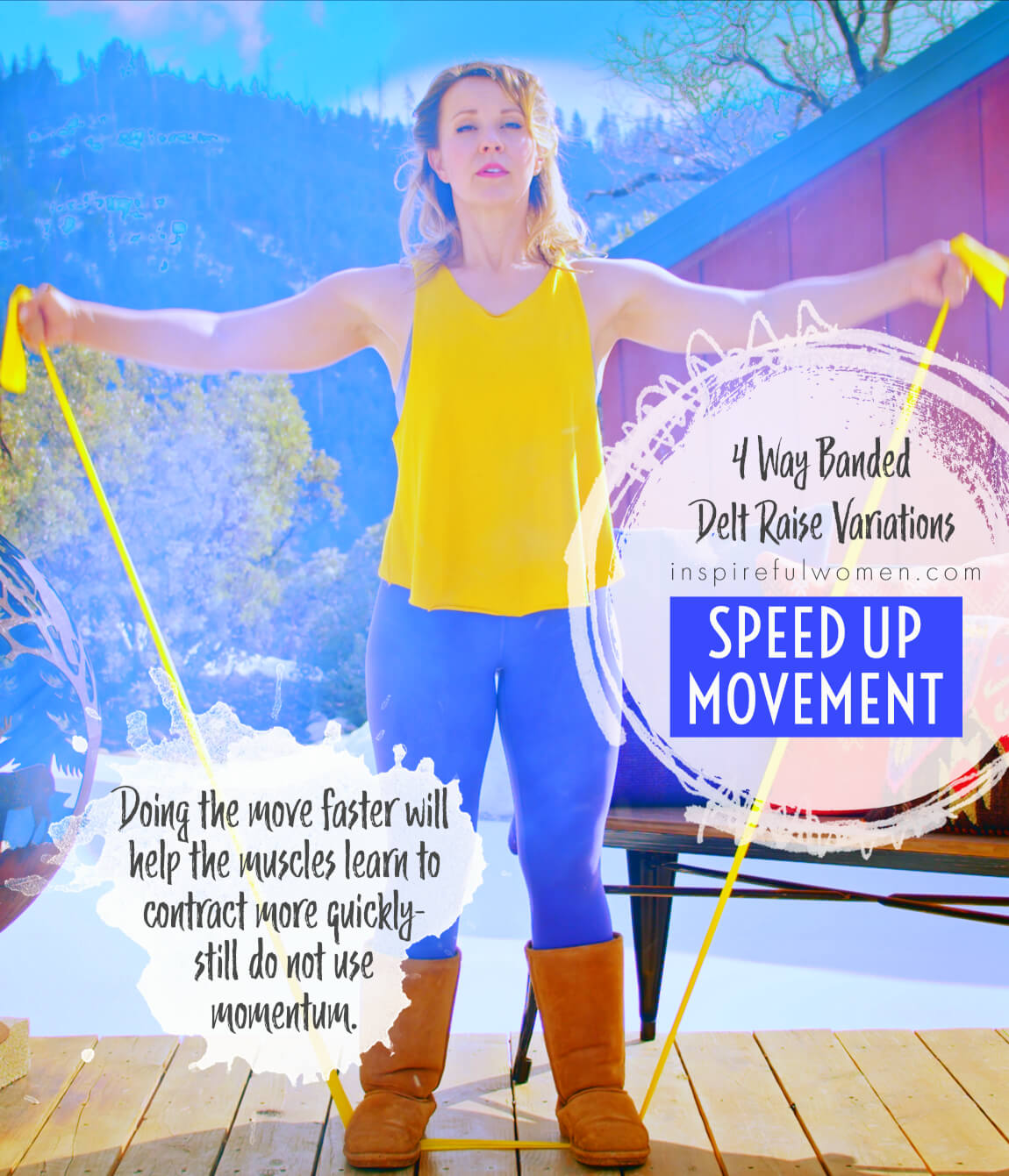
Change Angle of Arm
Shoulder Discomfort? Change Arm Angle 4-Way Delt Raise
Changing the angle that you do the pattern when you lift to the side might feel better on your shoulder- rather than lifting directly out to your side, you would lift out as if giving someone a big hug- being able to see your hands from the corners of your eyes - this is a more natural position for the arm bone in the shoulder socket and for those with any shoulder issues can be a healthier position - try this and see how it feels.
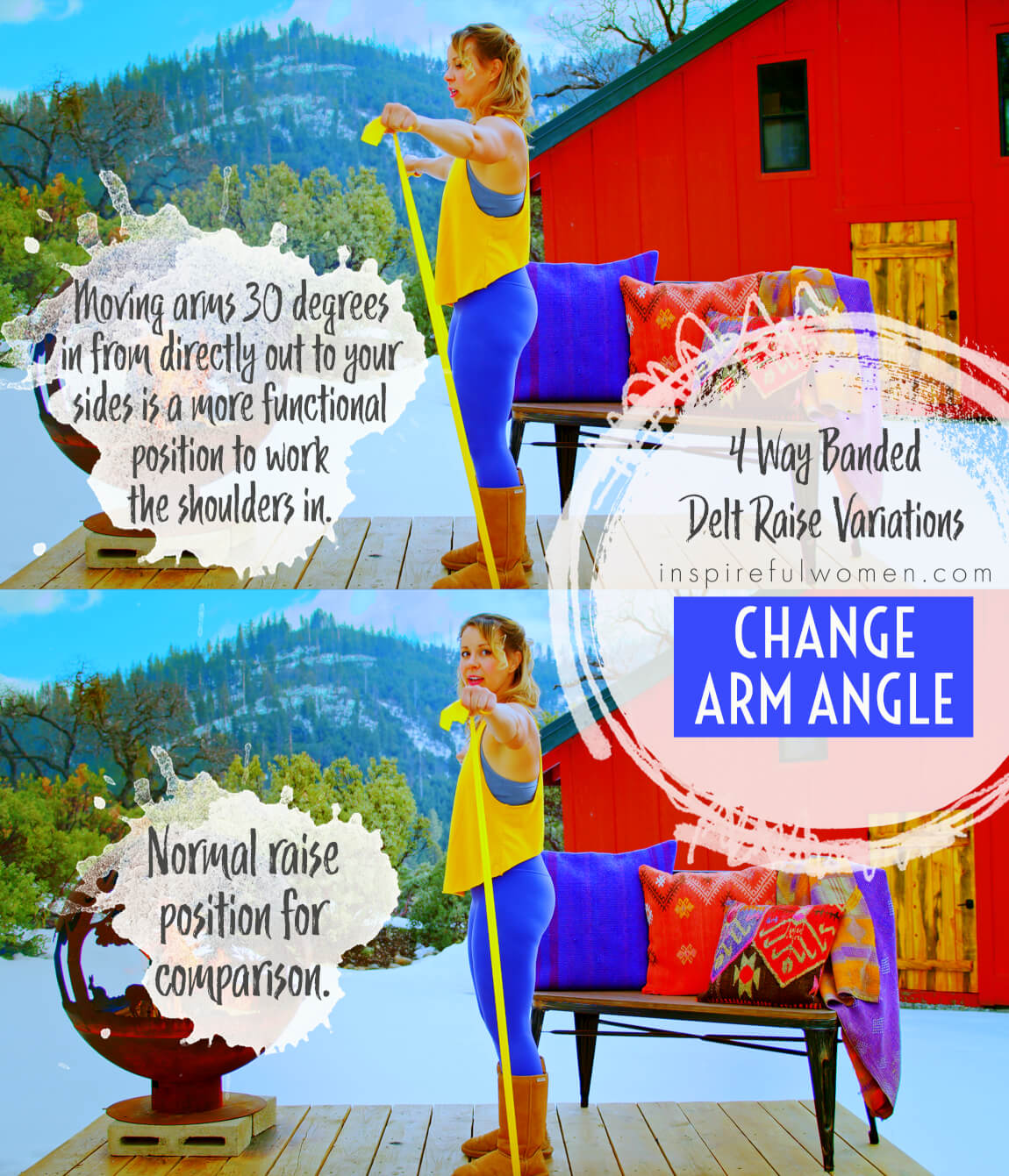
MAKE IT HARDER
HARDER
MAKING THE 4-Way Band Delt Raise MORE CHALLENGING
Iso Hold
Isometric Hold 4-way banded delt raise
Pause for 3 seconds every time you move to a new position AND the weight is parallel with the floor: lift arms out to the side, hold 3 seconds, move arms to the front, hold 3 seconds, move up - no hold, move back down to the front, hold 3 seconds, move out to the side, hold 3 seconds, move back down to sides, no hold. This will increase the total time that the muscles are under tension.

Slow Down
Slow down 4-way banded delt raise
Slow down so that each movement lasts for a 5-second count, for example: moving the arms from the sides to shoulder level = 5 seconds. This will increase the time the muscles are under tension and will increase the eccentric activity of the muscles.
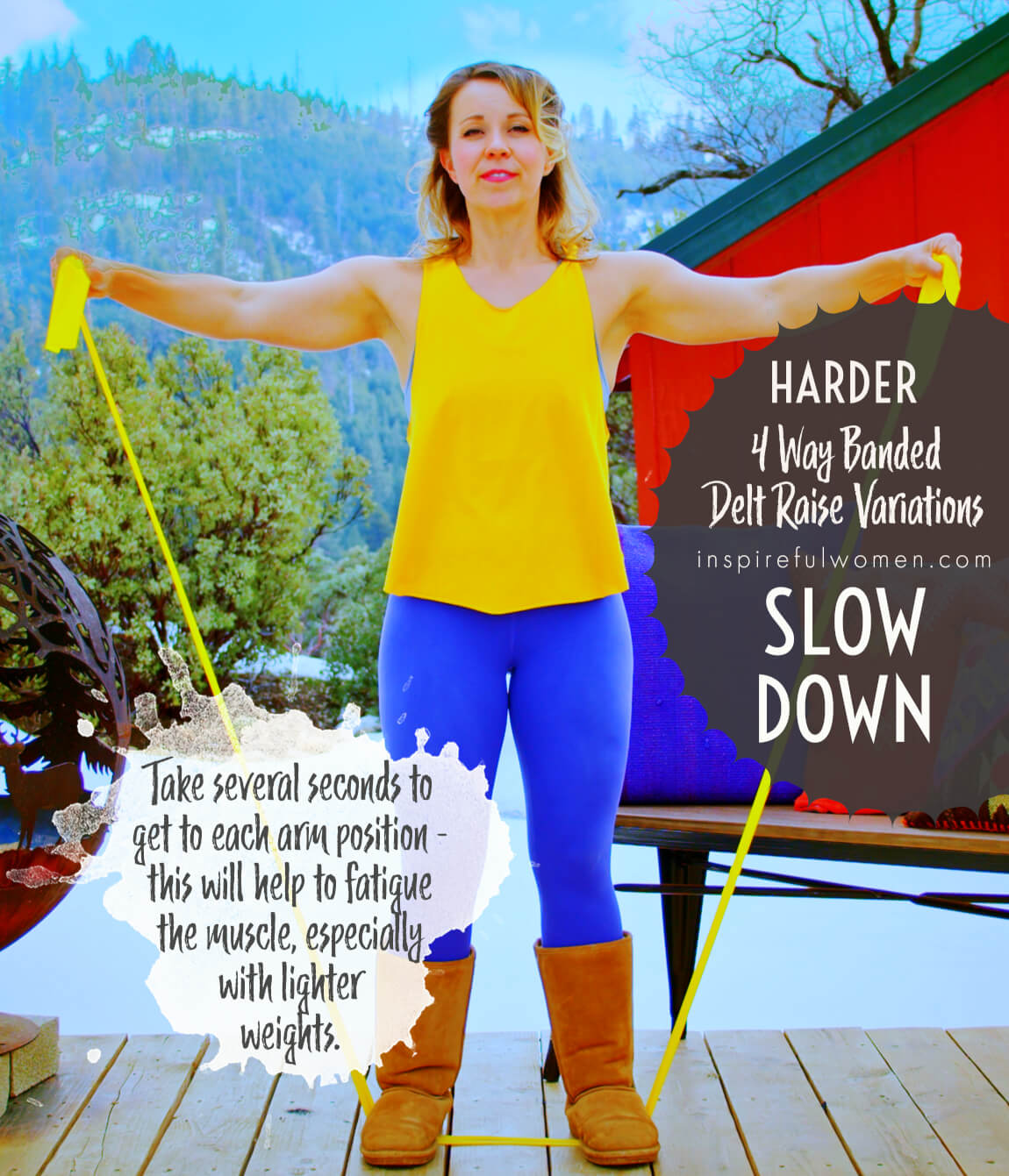
MAKE IT EASIER
EASIER
MAKE THE 4-Way Band Delt Raise MORE DOABLE
Simplify the movement
Simplify the movement

Seated
Seated on a chair
Sit on a chair or bench. Sit upright with both feet flat on the floor, the back does not rest against the back of the chair. In the seated position the core will work less than in standing.
Stability Ball
Seated on a Stability Ball
This will be less stable than seated (more core activation) but more stable than standing.

SCIENCY STUFF
SCIENCY STUFF
SPIFFILICIOUS FACTS ABOUT MUSCLES & MOVES
This movement helps to train the coordination of muscle activity under load with movement. This is a more functional exercise - instead of just moving a limb in one plane for the set number of reps.
This exercise involves moving the arm in all three planes - the frontal when the arm is lifted out to the side, the transverse when the arm moves to the front of the body, and the sagittal when the arm lowers down and in the front.
The exercise works the anterior and lateral deltoid both eccentrically and concentrically and keeps them under tension throughout the entire set.
ALLLL MUSCLES & WHEN
ALL MUSCLES WORKING & WHEN DURING THE 4-Way Band Delt Raise
The core stabilizers work to hold the spine in a neutral position throughout the exercise.
The muscles that move and stabilize the shoulder blade and the shoulder joint will work throughout the exercise - they work in coordination with the goal of keeping the head of the humerus (upper arm bone) stabilized within the shoulder socket (small cup on the shoulder blade. The muscle will contract and relax at varying levels of force for smooth motion and stability. The muscles involved include: the rotator cuff, rhomboids, trapezius, levator scapulae, latissimus dorsi, serratus anterior, and pectorals.
The biceps, triceps, and forearm muscles work to hold the elbow and wrist straight throughout the exercise.
To begin the supraspinatus (one of the rotator cuff muscles) and the lateral deltoid muscles contract concentrically to lift the arms out to the side. The supraspinatus only contributes for the first part of the movement, after that the lateral deltoid does the work. When the arms reach shoulder level, the deltoid muscle works isometrically to hold the arm at shoulder level. The muscles of the chest, the pectoralis, and coracobrachialis contract concentrically (there is not much effort here because there is very little resistance to this movement) to move the arms in. When the arms are in line with the shoulders (straight out in front), the anterior deltoids and biceps work isometrically. The rear delt works concentrically (not against resistance - so the effort is small) to pull the arm back horizontally. The lateral deltoid and supraspinatus work eccentrically to control the movement of the arm back down to the sides of the body.
After half of the reps the movement changes so the arms are lifted (flexed up to the front by a concentric contraction of the anterior deltoid, biceps, coracobrachialis. The same muscles along with the lateral deltoid work to hold the arm up as the rear delt works concentrically (not against resistance - so the effort is small) to pull the arm back horizontally.
The muscles of the chest, the pectoralis, and coracobrachialis, contract concentrically (there is not much effort here because there is very little resistance to this movement) to move the arms back to the front.
The anterior deltoid, coracobrachialis, and biceps work eccentrically to control the pull of the bands as the arms are lowered down to the front of the thighs.
PIN IT FOR LATER!





